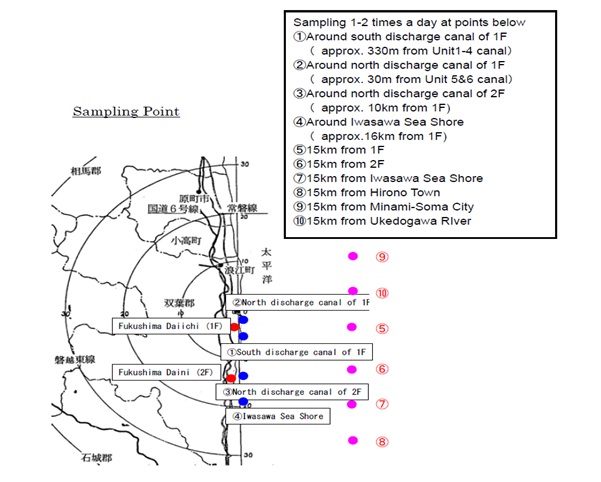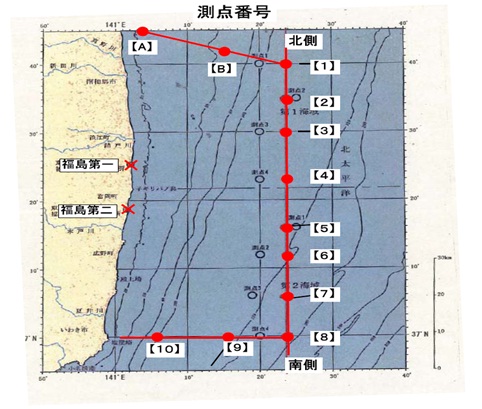→ Chronology of Updates:
2 June | 12-18 May | 4-11 May | 5 May | 3 May | 2 May | 28 April | 27 April | 26 April | 21 April | 20 April | 19 April | 18 April | 15 April | 14 April | 13 April | 12 April | 11 April | 10 April | 9 April | 8 April | 7 April | 6 April | 5 April | 4 April | 3 April | 2 April | 1 April | 31 March | 30 March | 29 March | 28 March | 27 March | 26 March | 25 March | 24 March | 23 March | 22 March | 21 March | 20 March | 19 March | 18 March | 17 March | 16 March | 15 March | 14 March | 13 March | 12 March | 11 March | Full Update
IAEA BRIEFING ON FUKUSHIMA NUCLEAR ACCIDENT (15 April 2011, 14:30 UTC)
Presentation:
→ Summary of Reactor Status
(Note: The next written brief will be available on Monday, 18 April, unless there are any significant developments.)
On Friday, 15 April 2011, the IAEA provided the following information on the current status of nuclear safety in Japan:
1. Current Situation
Overall, the situation at the Fukushima Daiichi nuclear power plant remains very serious but there are early signs of recovery in some functions, such as electrical power and instrumentation.
Changes to Fukushima Daiichi Plant Status
The transfer of contaminated water from the trench of the Unit 2 Turbine Building to the condenser started on 12 April and continued on 13 April until approximately 660 tonnes were transferred.
To minimize the movement of contaminated water to the open sea, temporary boards to stop water (3 steel plates in total) were installed on 13 April on the ocean-side of the Inlet Bar Screen of Unit 2.
Silt fences have also been installed in the inlet canal and in front of the Inlet Bar Screens of Units 1, 2, 3 and 4. On 11 April, a silt screen was installed at the southern end of the inlet canal. The installation in front of the Inlet Bar Screen of Units 3 and 4 was completed on 13 April and for Units 1 and 2 on 14 April.
As of 14 April, white "smoke" was still observed coming from Units 2 and 3. White "smoke" was also observed coming from Unit 4 on 14 April.
On 13 April, Japan's Nuclear and Industrial Safety Agency (NISA) reported that the Tokyo Electric Power Compan (TEPCO) had begun to install a backup line for providing fresh water to the Reactor Pressure Vessels (RPVs) at Units 1, 2, and 3.
In Unit 1, fresh water is being continuously injected into the RPV through the feed-water line at an indicated flow rate of 6 m3/h using a temporary electric pump with off-site power. In Units 2 and 3, fresh water is being continuously injected through the fire extinguisher lines at an indicated rate of 7 m3/h using temporary electric pumps with off-site power.
Nitrogen gas is being injected into the Unit 1 containment vessel to reduce the possibility of hydrogen combustion within the containment vessel. The pressure in this containment vessel has stabilised. The pressure in the RPV is increasing as indicated on one channel of instrumentation. The other channel shows RPV pressure as stable. In Units 2 and 3 Reactor Pressure Vessel and Drywell pressures remain at atmospheric pressure.
RPV temperatures remain above cold shutdown conditions in all Units, (typically less than 95 °C). In Unit 1, the temperature at the feed water nozzle of the RPV is 197 °C and at the bottom of the RPV is 119 °C. In Unit 2, the temperature at the feed water nozzle of the RPV is 150 °C. In Unit 3 the temperature at the feed water nozzle of the RPV is 91 °C and at the bottom of the RPV is 121 °C.
On 14 April, a concrete pump truck, with a capacity of 50t/h, began spraying fresh water to the Unit 3 spent fuel pool. In Unit 4, a sample of the water in the spent fuel pool was collected for analysis.
There has been no change in status in Unit 5 and 6 and the Common Spent Fuel Storage Facility.
2. Radiation Monitoring
On 14 April, depositions of both Iodine-131 and Cesium-137 were detected in 1 and 5 prefectures respectively. For both I-131 and Cs-137, the depositions detected were below 20 Bq/m2 at all stations.
Gamma dose rates are measured daily in all 47 prefectures. The values have tended to decrease over time. For Fukushima, on 14 April a dose rate of 2.0 µSv/h was reported. In the Ibaraki prefecture, a gamma dose rate of 0.14 µSv/h was reported. The gamma dose rates in all other prefectures were below 0.1 µSv/h.
Dose rates are also reported specifically for the Eastern part of the Fukushima prefecture, for distances beyond 30 km from Fukushima Daiichi. On 14 April, the values in this area ranged from 0.1 to 21 µSv/h.
In cooperation with local universities, Japan's Ministry of Education, Culture, Sports, Science and Technology (MEXT)has set up an additional monitoring programme and measurements of the gamma dose rates are made in 54 cities in 40 prefectures. As of 14 April, the gamma dose rates were below 0.1 µSv/h in 45 cities. In 8 cities, gamma dose rates ranged from 0.13 to 0.17 µSv/h. In Fukushima City, a value of 0.42 µSv/h was observed.
Only in a few prefectures, I-131 or Cs-137 is detectable in drinking water at very low levels. As of 12 April, one restriction for infants related to I-131 (100 Bq/l) is in place in a smallscale water supply in a village of the Fukushima prefecture.
On 14 April, an IAEA Team made measurements at 11 different locations in the Fukushima area at distances ranging from 15 to 39 km, South and Southwest from the Fukushima Daiichi nuclear power plant. At these locations, the dose rates ranged from 0.3 to 2.8 µSv/h. At the same locations, results of beta-gamma contamination measurements ranged from 0.16 to 2.5 MBq/ m2. The highest values were observed at distances of less than 23 km from the power plant.
NISA reported on 14 April that among approximately 300 workers at the Fukushima Daiichi plant, 28 have received accumulated doses exceeding 100 mSv in the period related to this emergency. No worker has received a dose above Japan's guidance value of 250 mSv for restricting the exposure of emergency workers.
Analytical results related to food contamination were reported by the Japanese Ministry of Health, Labour and Welfare on 14 April for a total of 50 samples taken from 11th to 14 April. Analytical results for all of the samples of various vegetables, mushrooms, fruits (strawberries), various meats, seafood and unprocessed raw milk in ten prefectures (Chiba, Fukushima, Gunma, Ibaraki, Kanagawa, Nagano, Niigata, Saitama, Tochigi and Yamagata) indicated that I-131, Cs-134 and/or Cs-137 were either not detected or were below the regulation values set by the Japanese authorities.
On 14 April, the Prime Minister of Japan approved the lifting of restrictions on the distribution of kakina in Tochigi prefecture.
3. Marine Monitoring
TEPCO Monitoring Programme
TEPCO is conducting a programme for seawater (surface sampling) at a number of near-shore and off-shore monitoring locations. (See Map 8: TEPCO Seawater Sampling Locations).
On some days, two samples were collected at the same sampling point, a few hours apart and analysed separately.
Until 3 April a general decreasing trend in radioactivity was observed at the sampling points TEPCO 1 to TEPCO 4. After the discharge of contaminated water on 4 April, a temporary increase in radioactivity was reported. Since 5 April, a general downward trend in the concentration of radionuclides in sea water for all TEPCO sampling points has been observed.
On 15 April, new data for TEPCO 1 - 4 sampling points have been reported. At all four locations, the concentration of both I-131 and Cs-137 measured on 12 April was below 2kBq/l.
For TEPCO 5 - 10 no new data have been reported.
MEXT Off-shore Monitoring Programme
MEXT initiated the off-shore monitoring program on 23 March and subsequently points 9 and 10 were added to the off-shore sampling scheme. On 4 April, MEXT added two sampling points to the north and west of sampling point 1. These are referred to as points A and B. (See Map 9: MEXT Seawater Sampling Locations).
The most recent results reported on 11 April showed that Cs-137 was only detected at MEXT 4 (below 100Bq/l). The highest concentration of I-131 (about 90 Bq/l) was also recorded at MEXT 4. For other sampling locations I-131 was reported at levels below about 15 Bq/l.
On 15 April, no new data from any MEXT sampling points have been reported.
Map 8: TEPCO Seawater Sampling Locations:

Map 9: MEXT Seawater Sampling Locations:

4. IAEA Activities
The 141st Session of the FAO Council was briefed by representatives of the Joint FAO/IAEA Division on the nuclear emergency in Japan on Friday, 15 April, at the FAO Headquarters in Rome, Italy. The briefing included a general background summary of the emergency, the current situation in Japan, FAO/IAEA/WHO responses and actions taken to date, and future challenges. The Member States expressed their appreciation for the IAEA/FAO/WHO inter-agency collaboration and coordination during the Japanese nuclear emergency and called for strengthening cooperation in future remediation actions.

